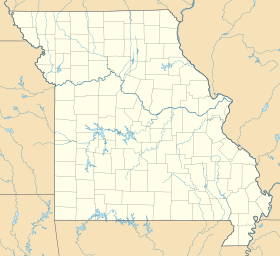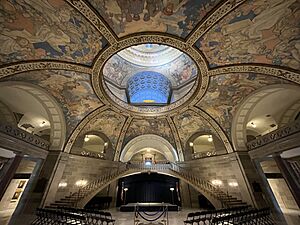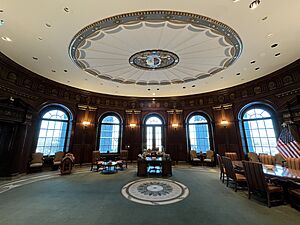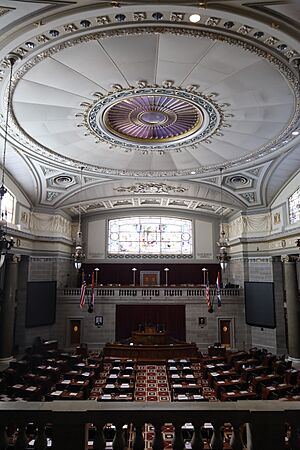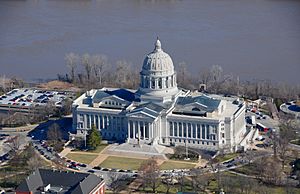Missouri State Capitol facts for kids
Quick facts for kids |
|
|
Missouri State Capital Building and Grounds
|
|
|
U.S. Historic district
Contributing property |
|
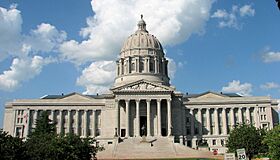 |
|
| Location | 201 West Capitol Avenue, Jefferson City, Missouri |
|---|---|
| Area | 3 acres (1.2 ha) |
| Built | 1917 |
| Architect | Tracy and Swartwout |
| Architectural style | Classical Revival |
| NRHP reference No. | 69000096 |
| Added to NRHP | June 23, 1969 |
The Missouri State Capitol is where the government of the U.S. state of Missouri works. It's home to the state's lawmakers, known as the Missouri General Assembly, and the executive branch, which includes the governor. You can find this important building in Jefferson City at 201 West Capitol Avenue.
This building is actually the third state capitol built in Jefferson City. The first two were destroyed by fires. The current building has a big dome and was finished in 1917. A company called Tracy and Swartwout designed it. The capitol's dome is often the first thing people see when they come to Jefferson City from the north.
Inside the capitol, you'll find the offices for the state Senate and House of Representatives. It also has offices for the governor, lieutenant governor, and other important state officials.
The Missouri State Capitol is listed on the National Register of Historic Places. It's also the most popular tourist spot in Jefferson City. Many school groups visit, especially when the General Assembly is meeting. Students can watch the Senate and House of Representatives in action from the viewing galleries.
Contents
Exploring the Capitol Building
Outside the Capitol: Art and Gardens
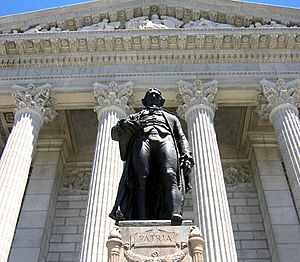
The outside of the Missouri State Capitol is very impressive. It has a large dome that looks a bit like St. Peter's Basilica in Rome. This dome rises about 238 feet (72.5 meters) above the ground. On top of the dome, there's a bronze statue of Ceres, the Roman goddess of farming, created by sculptor Sherry Fry.
The building also features many tall columns. There are eight columns on the south side and six on the north side. A wide grand staircase leads up to the entrance. The bronze entrance doors are huge, each measuring about 13 by 18 feet (4 by 5.5 meters). When they were made, they were some of the largest cast doors since ancient Roman times.
The north side of the building has a sculpted band called a frieze by Hermon Atkins MacNeil. It shows scenes from Missouri's history. The south side continues this theme with art by Alexander Stirling Calder. The figures above the main entrance were sculpted by Adolph Alexander Weinman.
The capitol grounds are filled with statues. At the south entrance, you'll see large bronze figures by Robert Ingersoll Aitken that represent Missouri's two big rivers, the Mississippi and the Missouri. There's also a 13-foot (4-meter) tall statue of Thomas Jefferson by James Earle Fraser. Two fountains, called "The Sciences and The Arts Fountains," each with four figures, decorate the south lawn.
On the north grounds, you can find a bronze relief by Karl Bitter. It shows the signing of the Louisiana Purchase agreement. Weinman's "Fountain of the Centaurs" is also located there.
Inside the Capitol: Murals and History
The first floor of the capitol is home to the State Museum. It's decorated with beautiful mural paintings and statues. One of the main attractions is a series of murals painted by Thomas Hart Benton in the House Lounge.
As you go up the grand staircase, you'll see large bronze statues of Meriwether Lewis and William Clark. On the third floor, the rotunda is where you'll find the Hall of Famous Missourians. This area displays bronze busts of important Missourians who are honored for their achievements.
High up inside the dome, there's a special area called a whispering gallery. If you whisper on one side, someone on the other side can hear you clearly! There's also a small viewing platform on the dome's roof, right under the statue of Ceres. These areas are usually only open for school tours and other special visits.
History of Missouri's Capitols
The current capitol building, finished in 1917, is the third one in Jefferson City. It's actually the sixth state capitol in Missouri's history!
Earlier Capitol Buildings
Missouri's first state government met in St. Louis. The second capitol was in St. Charles, which was the temporary state capital from 1821 to 1826.
Leaders decided the capitol should be more in the center of the state. They chose the current spot in Jefferson City because it had the best view of the Missouri River.
The fourth state capitol, and the first in Jefferson City, was a two-story brick building. It was completed around 1828 for about $18,500. This building, called the "Governor's House and State Capitol," burned down in 1837. Today, the Missouri Governor's Mansion stands on that site. An architect named Stephen Hills designed it.
The fifth capitol building was built on the current site and finished in 1840. It cost about $350,000. This building also burned down on February 5, 1911, after being struck by lightning. By 1911, this building was too small for the state's needs. State Senator William Warner even said he wasn't sad it was destroyed because it was too small for "our great state."
The Current Capitol Building
When they planned the new capitol, the budget was $3 million for construction and an extra $500,000 for the site and furniture. The public approved this plan. However, the state collected more money than expected, about $4,215,000. All of this money was used for the project, which is why the sculptures and artwork inside are so beautiful and high quality.
The state held a design competition to choose the architect. They removed names from the submissions to make sure there was no favoritism. Out of 69 architectural firms, Tracy & Swarthout from New York City was chosen.
The building's design is balanced, giving equal importance to the House of Representatives and the state Senate. It looks similar to the United States Capitol in Washington, D.C., and also to ancient Greek and Roman temples. The stone used for the outside is a strong marble from Carthage, Missouri. Over 100 years, some of the details have worn away due to weather. The state has spent $30 million to study and restore the building.
The capitol is five stories tall. It is about 437 feet (133 meters) long and 300 feet (91 meters) wide in the center. The dome is 238 feet (72.5 meters) high. The building has about 500,000 square feet (46,451 square meters) of floor space.
The Chandelier Incident
In November 2006, the huge 9,000-pound (4,082 kg) chandelier in the dome fell about five feet after being lowered for maintenance. It was damaged and sent away for repairs. Almost a year later, in 2007, the chandelier was returned to Jefferson City and put back in place. The lights at the top of the dome were also turned back on after being off for 40 years to protect a mural. The chandelier was made in 1918 for $5,000, but it cost $500,000 to restore it in 2006.
See also
 In Spanish: Capitolio del Estado de Misuri para niños
In Spanish: Capitolio del Estado de Misuri para niños
- List of Missouri General Assemblies
- List of state and territorial capitols in the United States


